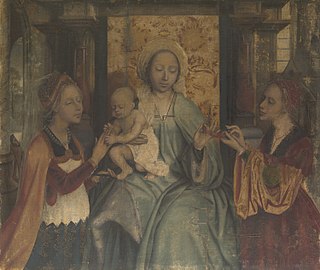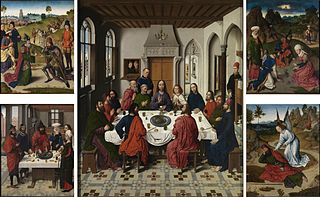
Leuven or Louvain is the capital and largest city of the province of Flemish Brabant in the Flemish Region of Belgium. It is located about 25 kilometres east of Brussels. The municipality itself comprises the historic city and the former neighbouring municipalities of Heverlee, Kessel-Lo, a part of Korbeek-Lo, Wilsele and Wijgmaal. It is the eighth largest city in Belgium, with more than 100,244 inhabitants.

Hugo van der Goes was one of the most significant and original Flemish painters of the late 15th century. Van der Goes was an important painter of altarpieces as well as portraits. He introduced important innovations in painting through his monumental style, use of a specific colour range and individualistic manner of portraiture. From 1483 onwards, the presence of his masterpiece, the Portinari Triptych, in Florence played a role in the development of realism and the use of colour in Italian Renaissance art.

Dieric Bouts was an Early Netherlandish painter. Bouts may have studied under Rogier van der Weyden, and his work was influenced by van der Weyden and Jan van Eyck. He worked in Leuven from 1457 until his death in 1475.

The Old University of Leuven is the name historians give to the university, or studium generale, founded in Leuven, Brabant, in 1425. The university was closed in 1797, a week after the cession to the French Republic of the Austrian Netherlands and the principality of Liège by the Treaty of Campo Formio.

The Entombment is a glue-size painting on linen attributed to the Early Netherlandish painter Dieric Bouts. It shows a scene from the biblical entombment of Christ, and was probably completed between 1440 and 1455 as a wing panel for a large hinged polyptych. While the altarpiece remains lost as a complete set, it is thought to have contained a central crucifixion scene flanked by four wing panel works half its height – two on either side – depicting scenes from the life of Christ. The smaller flanking panels would have been paired in a format similar to Bouts's 1464–1468 Altarpiece of the Holy Sacrament. The larger work was probably commissioned for export to Italy, possibly to a Venetian patron whose identity is lost. The Entombment was first recorded in a mid-19th-century inventory in Milan, and has been in the National Gallery, London, since its purchase on the Gallery's behalf by Charles Lock Eastlake in 1861.

Virgin and Child with Four Angels is a small oil-on-panel painting by the Early Netherlandish artist Gerard David. Likely completed between 1510 and 1515, it shows the Virgin Mary holding the child Jesus, while she is crowned Queen of Heaven by two angels above her, accompanied by music provided by another two angels placed at either side of her. In its fine detail and lush use of colour the work is typical of both David and late period Flemish art.

Glue-size is a painting technique in which pigment is bound (sized) to cloth with hide glue, and typically the unvarnished cloth was then fixed to the frame using the same glue. Glue-size is also known as distemper, though the term "distemper" is applied variously to different techniques. Glue-size was used because hide glue was a popular binding medium in the 15th century, particularly among artists of the Early Netherlandish period, who used it as an inexpensive alternative to oil. Although a large number of works using this medium were produced, few survive today, mainly because of the high perishability of linen cloth and the solubility of hide glue. Well-known and relatively well-preserved – though substantially damaged – the most notable examples include Quentin Matsys' Virgin and Child with Saints Barbara and Catherine and Dirk Bouts' Entombment. In German the technique is known as Tüchleinfarben, meaning "small cloth colours", or Tüchlein, derived from the German word for “handkerchief”.

The Crucifixion and Last Judgement diptych consists of two small painted panels attributed to the Early Netherlandish artist Jan van Eyck, with areas finished by unidentified followers or members of his workshop. This diptych is one of the early Northern Renaissance oil-on-panel masterpieces, renowned for its unusually complex and highly detailed iconography, and for the technical skill evident in its completion. It was executed in a miniature format; the panels are just 56.5 cm (22.2 in) high by 19.7 cm (7.8 in) wide. The diptych was probably commissioned for private devotion.

The Christ and the Virgin Diptych consisted of two small oil on oak panel paintings by the Early Netherlandish painter Dirk Bouts completed c. 1470-1475. Originally they formed the wings of a hinged devotional diptych.

Lieven van Lathem (1430–1493), was an Early Netherlandish painter and manuscript illuminator.

Jan Rombouts the Elder, Jan Rombouts (I) (c. 1480 in Leuven – 1535 in Leuven), was a Flemish Renaissance painter, glass painter, draftsman, printmaker and glass designer. The subjects of his work are stories from the Old and New Testament and the lives of Christian saints. He was active in Leuven where he introduced the Renaissance innovations of Bernard van Orley and the Antwerp school.

A winged altarpiece or winged retable is a special form of altarpiece, common in Northern and Central Europe, in which the central image, either a painting or relief sculpture can be hidden by hinged wings. It is called a triptych if there are two wings, a pentaptych if there are four, or a polyptych if there are four or more. The technical terms are derived from Ancient Greek: τρίς: trís or "triple"; πέντε: pénte or "five"; πολύς: polýs or "many"; and πτυχή: ptychē or "fold, layer".

Portrait of Maria Portinari is a small c. 1470–72 painting by Hans Memling in tempera and oil on oak panel. It portrays Maria Maddalena Baroncelli, about whom very little is known. She is about 14 years old, and depicted shortly before her wedding to the Italian banker, Tommaso Portinari. Maria is dressed in the height of late fifteenth-century fashion, with a long black hennin with a transparent veil and an elaborate jewel-studded necklace. Her headdress is similar and a necklace identical to those in her depiction in Hugo van der Goes's later Portinari Altarpiece, a painting that may have been partly based on Memling's portrait.

Altarpiece of the Holy Sacrament or Triptych of the Last Supper is a 1464–1468 dated folding triptych with at least five panel paintings attributed to Dieric Bouts, now reassembled and held at its location of origin in the eastern choir chapel of St. Peter's Church, Leuven, Belgium.
Jan Van der Stock is a Belgian art historian and exhibition curator. He is a full professor at the University of Leuven, where he lectures on Medieval and Renaissance Arts, Graphic Arts, Iconography, Iconology, and Curatorship. He is the director of Illuminare – Centre for the Study of Medieval Art and holder of the Van der Weyden Chair – Paul & Dora Janssen, the Veronique Vandekerchove Chair of the City of Leuven and the Chair of Medieval Sculpture in the Low Countries. Jan Van der Stock was the husband of Prof. dr. Christiane Timmerman and is the father of Willem and Liza Van der Stock.

The Fall of the Damned is an oil on panel painting by Dieric Bouts, completed in 1470. It was produced as the rightmost section of a triptych of a Last Judgment scene commissioned for the town hall of Louvain, Belgium, in 1468. The central panel of the triptych is lost, but the left side panel, the Ascension of the Elect, survives along with the Fall of the Damned. The set of images would have drawn narrative inspiration from Genesis 2:10, the Book of Revelation and from the Purgatory of St Patrick, a 14th-century Irish manuscript by Berol telling of Sir Owein's legendary trip to Purgatory. The Fall has been on permanent loan from the Louvre to the Palais des Beaux-Arts de Lille, where it has been reunited with the Ascension since 1957.

The Martyrdom of Saint Erasmus by Dieric Bouts is a triptych panel painting in the collegiate church of Saint Peter's in Leuven, Belgium. It commemorates the martyrdom and death of a European Christian figure from the fourth century, Saint Erasmus. It shows the Emperor Diocletian as one of four observers in the background of the center panel, as well as Saints Jerome and Bernard of Clairvaux in the wings of the altarpiece. All nine figures appear to express an exceptional tranquility and calm, in a landscape setting that is contiguous across the three panels.

The sacrament tower of St. Peter's Church in Leuven, Belgium is a twelve-meter high sacrament house located in the church's choir. Designed by architect Matheus de Laeyens from 1450, it was ordered by the Brotherhood of the holy Sacrament. The tower in St. Peter's Church was built between 1537 and 1539 and this makes it the oldest preserved sacrament tower in Belgium.

Lamentation of Christ is an Early Netherlandish panel painting made 1455–1460 by Flemish painter Dirk Bouts of the Lamentation of Christ. the picture was bequeathed to the Louvre Museum by Constant Mongé-Misbach in 1871, at which time it was misattributed to Rogier van der Weyden. It remains in that museum's collection as RF 1.


















